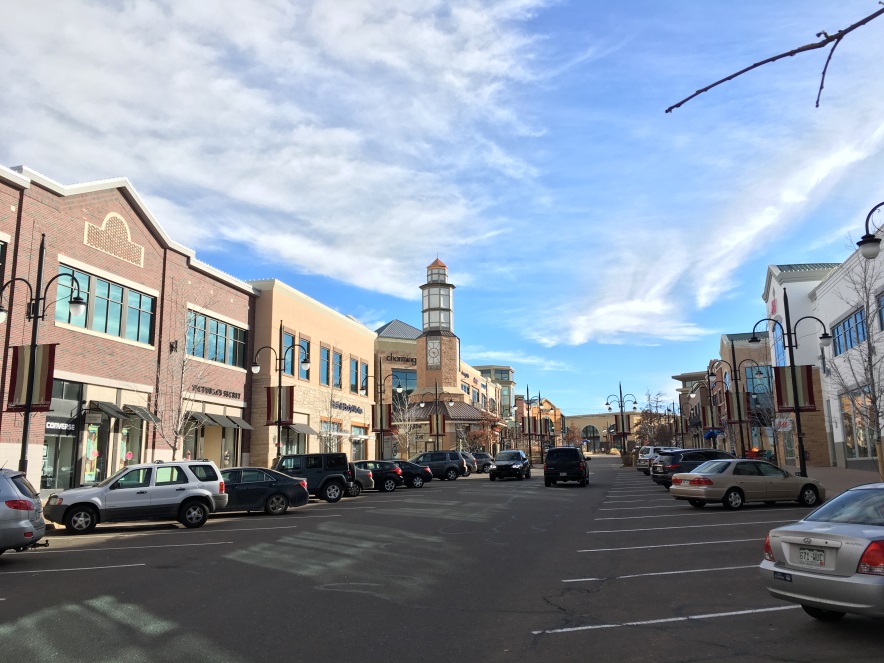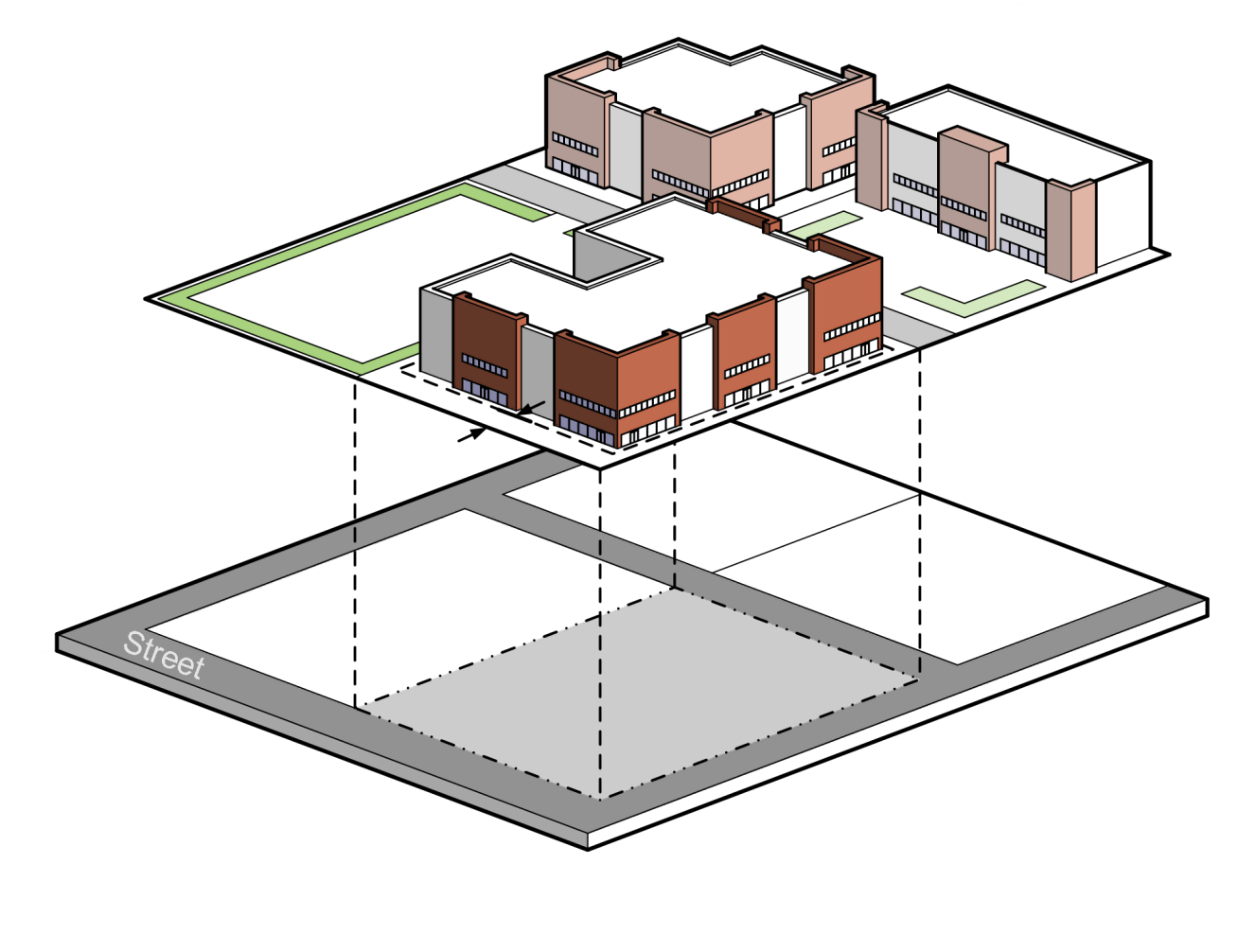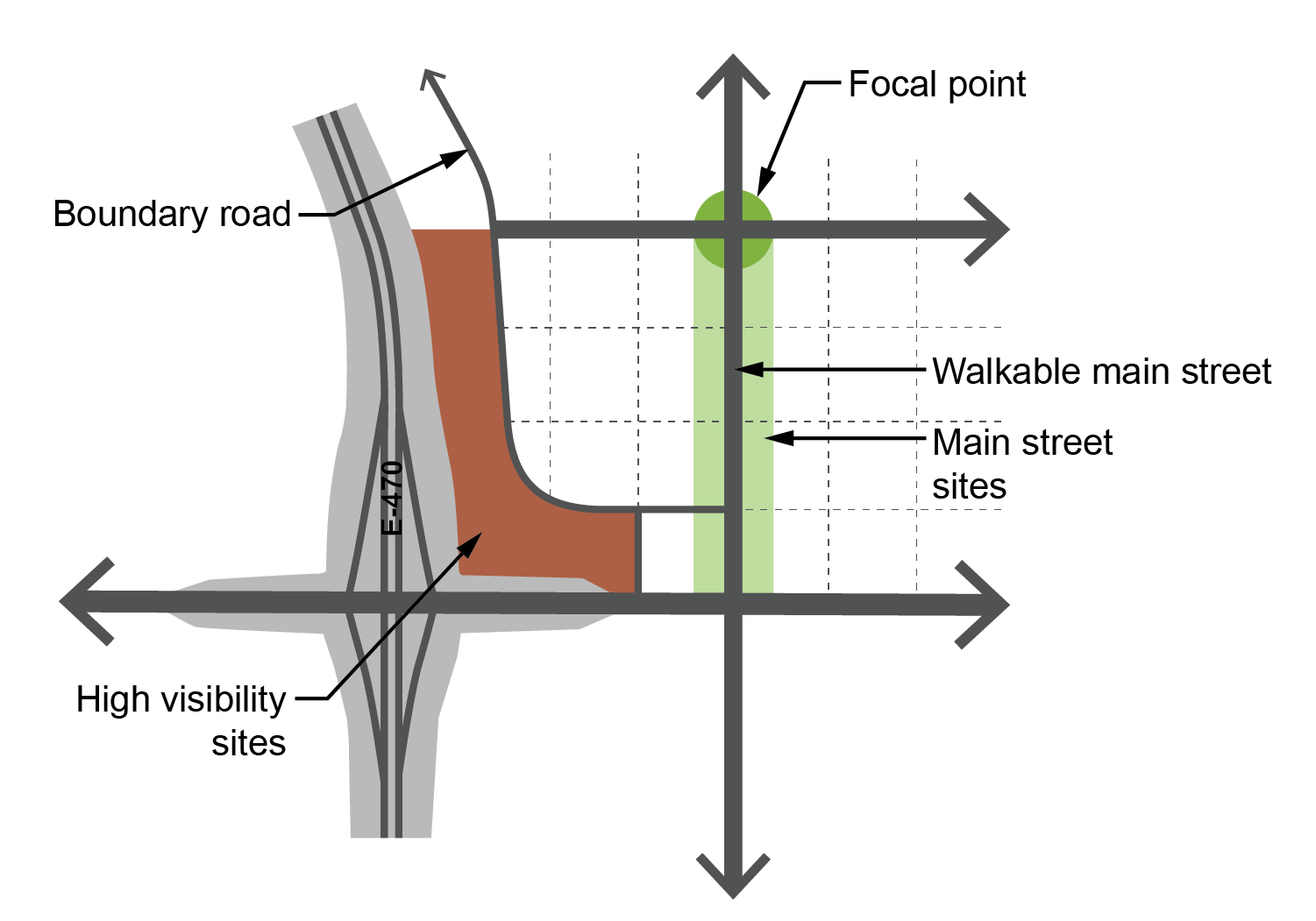2.4.7. MIXED-USE -- REGIONAL DISTRICT (MU-R).
A. Purpose. The MU-R district is intended to serve “image making” areas in Aurora such as gateways, major arterial street and highway intersections, and regional activity centers. The MU-R district allows for a mix of medium- to high-density residential and regional commercial uses, as well as other uses as shown in Table 3.2-1 (Permitted Use Table). The MU-R district intends to promote a distinctive, unified character and to ensure high quality development. More specifically, the district intends to promote:
1. A larger scale of development that presents a recognizable skyline or silhouette, and a visible transition in building massing and concentration from a visible focal point;
2. A safe and pleasant pedestrian and bicycle environment connected to the streets and walkways;
3. Nodes for multi-modal movement, including mass transit facilities; and
4. A pleasant visual environment with high-quality architectural materials, properly sized and positioned signage, and intensive landscaping with generous outdoor common areas.

B. Cross-References to Other Applicable UDO Sections. All development and redevelopment must comply with all applicable sections of this UDO. A short summary of some of the key sections is shown below.
|
Table 2.4-10 Cross-References to Other Applicable UDO Sections |
|
|---|---|
|
Use Regulations |
Article 146-3 |
|
Dimensional Standards |
Section 146-4.2 |
|
Neighborhood Protection Standards |
Section 146-4.4 |
|
Lot Access and Connectivity |
Section 146-4.5 |
|
Parking, Loading, and Stacking |
Section 146-4.6 |
|
Landscaping, Screening and Stormwater Management (including fence and wall regulations) |
Section 146-4.7 |
|
Building Design Standards |
Section 146-4.8 |
|
Signs |
Section 146-4.10 |
C. Dimensional Standards.

Basic dimensional standards for the MU-R zone district are in Table 4.2-3, and more detailed standards are located throughout Section 146-4.2 (Dimensional Standards).
D. Applicability of Standards.
1. The standards in Subsections E through M below apply to all initial development in an MU-R district in Subareas B or C begun after the Effective Date of this UDO.
2. Each development or redevelopment in an MU-R district in Subarea B or C approved or constructed before the Effective Date of this UDO with any of features or elements identified in Subsections E through M below shall continue to include them during any subsequent redevelopment of the property.
3. The requirements of Subsections E (Required Elements), F (Street Network and Pedestrian Circulation), and G (Location of Certain Land Uses) below apply to each MU-R development as a whole, and not to each lot within an MU-R district.
E. Required Elements. Each development in the MU-R district shall contain the following elements:
1. An identified focal point that serves as the center of the area with the highest development density or the most intense activity in the MU-R zone district. If the property abuts the E-470 right-of-way, the focal point shall include a distinctively designed building or feature that is visible from E-470 and that is immediately adjacent to the walkable main street element. The focal point shall be connected to the main street and may be located within a high visibility site. The tallest buildings and the buildings with the highest development density within the MU-R zone district shall be located on focal point sites, which shall include all the land within 660 feet of the focal point, and which may also (at the applicant’s option) include any additional land located within 660 feet of the main street.
2. At least one public plaza or outdoor meeting area at the intersection of each arterial street with another arterial street or with a collector street, which includes a corner design element with architectural or urban design features, and which contains at least 600 square feet of plaza or meeting area.
3. At least two of the uses identified in Table 3.2-1 (Permitted Use Table).
4. At least one Walkable Main Street (which may but does not have to accommodate automobile traffic) that connects the MU-R district to one of the adjacent arterial or local streets;
5. At least 40 percent of the street frontage of each development parcel fronting on the Walkable Main Street shall be bordered by plazas or buildings with façades located no more than 15 feet from the sidewalk;
6. There shall be direct pedestrian, bicycle, and automobile access (without the need to travel along an arterial street) from the interior of the MU-R district to a local street.
7. If the property is adjacent to E-470, it shall include identified high visibility sites defined as a single row of building sites located between the E-470 right-of-way and a boundary road that generally parallels the alignment of E-470 (and also turns to parallel the alignment of I-70 at the E-470/I-70 interchange) and terminates other streets running toward E-470. The boundary road shall be located at least 300 feet from the E-470 right-of-way to define a single row of building sites located between the boundary road and E-470, which are referred to as high visibility sites. In the case of a regional shopping center or other regional use containing at least 1,000,000 square feet of gross floor area, the boundary road may (at the applicant’s option) be a frontage road located closer than 300 feet to the E-470 or I-70 rights-of-way. When the boundary road is designed as a frontage road, the areas between the boundary road and the E-470 and I-70 rights-of-way shall meet the parking lot perimeter landscaping requirements of Section 146-4.7.5.K(5).

F. Street Network and Pedestrian Circulation. In addition to meeting the standards of Section 146-4.5 (Access and Connectivity), each development in the MU-R shall comply with the following:
1. Street Networks. Each MU-R district shall include a street network of arterial, collector, and local streets meeting all street spacing and layout requirements of the Aurora Roadway Design and Construction Specifications Manual. Those regulations generally call for:
a. An arterial street on each section line;
b. A collector street on each half-section line; and
c. One continuous north-south connection and one continuous east-west connection through each quarter-section of land or other area defined by the arterial and collector street network.
d. Bicycle lanes and other circulation facilities shall be provided as identified in the Aurora Roadway Design and Construction Specifications Manual and approved by the Public Works Department.
2. Pedestrian Circulation.
a. All development shall comply with sidewalk requirements of the Aurora Roadway Design and Construction Specifications Manual; and
b. A network of walkways that directly connects each major pedestrian entrance of each primary building to the sidewalk system or another primary building, so that pedestrians can move from each site perimeter street to each major pedestrian entrance of a primary building on a sidewalk or walkway.
3. Specific Sites.
a. Walkable Main Street Sites. Sidewalks along the Walkable Main Street shall comply with the Aurora Roadway Design and Construction Specifications Manual standards for a high priority pedestrian street.
b. High Visibility Sites. For sites adjacent to the E-470 right-of-way, the pedestrian circulation network does not need to extend between the Boundary Road toward E-470 except as necessary to link to a pedestrian or bicycle trail or walkway along the same side of E-470.
c. Architectural Features. Where a building or structure is located at the end of a T intersection on the internal automobile circulation system, the building or structure shall incorporate at least one distinct architectural feature, such as a tower, pergola, arcade, arch, or fountain.
G. Location of Certain Land Uses. If the property is in Subarea C:
1. Uses in the Vehicle-Related Operations category in Table 3.2-1 shall not be permitted on Focal Point sites, on lots fronting the Walkable Main Street, or on High Visibility Sites.
2. Drive-up and drive-through uses shall not be permitted on Walkable Main Street sites or High Visibility sites.
H. Outdoor Common Area.
1. Standards Applicable to All Development in Subarea C. At least 25 percent of the land area within each non-residential development site (except Walkable Main Street sites) shall be outdoor common area, which shall be located and landscaped to connect with adjacent public spaces.
2. Standards Applicable to Walkable Main Street Sites.
a. Walkable Main Street sites shall not be required to provide 25 percent outdoor common area, but shall be required to meet Aurora Roadway Design and Construction Specifications Manual requirements for curbside landscaping and applicable parking lot and perimeter landscaping described below.
b. A minimum of one open plaza at least 2,500 square feet in size with public seating areas shall be created on at least one side of Walkable Main Street.
c. Where buildings are adjacent to a plaza adjacent to a Walkable Main Street site, they shall contain at least one of the following elements facing the plaza: building entries or windows, arcades, outdoor seating areas or cafes, or a similar feature that encourages pedestrian use of the plaza.
3. Public Spaces for Dedication to the City.
a. Public spaces shall be designed to promote social interaction, leisure opportunities, public gathering and activities, and/ or to create focal points and activity nodes within development.
b. All development and redevelopment that includes residential uses shall dedicate land on-site for neighborhood park purposes in accordance with the standards of Section 146-4.3.18.B (Park and Open Space Lands and Cash-in-Lieu) and the dedication and design criteria set forth in the Parks, Recreation and Open Space Dedication and Development Criteria Manual. A cash-in-lieu payment may not be used to satisfy the neighborhood park land dedication requirement in its entirety.
I. On-Site Parking.
1. Standards Applicable to High Visibility Sites. No more than 50 percent of the E-470 frontage shall be occupied by surface parking except where such parking would not be visible from E-470 due to terrain or pre-existing vegetation.
2. Standards Applicable to Walkable Main Street Sites.
a. No more than 15 percent of the Walkable Main Street frontage of any site shall be occupied by off-street parking.
b. Where ground floors of parking structures front onto Walkable Main Street, the parking structures shall either (1) have all ground floor frontages located within 30 feet of the street occupied by non-parking uses, or (2) have driving aisles, ceiling heights, utility layouts, and structural openings designed to be consistent with future occupancy of the ground floor street frontage by consumer retail or service uses.
c. Parking areas shall be designed to be shared between nearby uses to the maximum extent practicable.
J. Building Height, Massing, Setbacks and Build-To Lines.
1. Buildings shall use height and massing to emphasize important corners, designate points of entry, and create a visible skyline to differentiate the MU-R zone districts as more significant activity nodes than surrounding areas.
2. Where property is located within 500 feet of the E-470 right-of-way, sites shall be designed to preserve views from the MU-R zone district to E-470 and views from E-470 into the MU-R zone district.
3. Taller buildings shall be located near Focal Points to the maximum extent practicable to reinforce the importance of the MU-R intersections when viewed from a distance along I-70, I-225, or E-470
K. Building Orientation.
1. High Visibility Sites. Buildings shall be oriented so that major primary pedestrian entries face the Boundary Street, but the façade facing E-470 shall be finished with the same mix of materials and colors and the same degree of fenestration and articulation used on the major entry walls facing the Boundary Street.
2. Focal Point Sites. Buildings on Focal Point sites shall be oriented so that primary pedestrian entries face the Walkable Main Street, but any façade facing an arterial or collector street shall be finished with the same mix of materials and colors and the same degree of fenestration and articulation used on the major entry walls facing the Walkable Main Street.
3. Walkable Main Street Sites. Buildings adjacent to the Walkable Main Street shall be oriented so that primary pedestrian entries face that street.
L. Architectural Elements.
1. Standards Applicable to All Development. Within each MU-R district, each building taller than 50 feet and each building larger than 100,000 square feet shall include at least one common architectural element that visually links such buildings to each other and distinguishes the MU-R from other MU-R areas when viewed from I-70, I-225, or E-470. The common architectural element shall be chosen by the developer of the first building required to contain that element, at the time of such development. Common architectural elements may include building materials of a distinctive color, common lighting features to accent building cornices or rooflines, common roof shapes, or other elements readily visible and distinguishable by motorists traveling E-470 or other major highways.
2. Standards Applicable to Walkable Main Street Sites. Where a primary structure fronts on a Walkable Main Street, the following additional design requirements shall apply:
a. Between 25 percent and 50 percent of the ground floor façade of non-residential primary structures facing the Walkable Main Street shall be made of glass rather than opaque materials.
b. Each 20 to 30 feet of linear distance of the façade facing the Walkable Main Street shall contain at least one vertical or horizontal protrusion or reveal at least eight inches wide and at least four inches in depth from the wall plane of the façade. Such scaling elements shall be repeated in a consistent rhythm along the façade.
c. The pedestrian entry to the primary structure from the Walkable Main Street shall be emphasized through changes in plane, differentiation in material and/or color, or greater level of detail.
d. Walkable Main Street façades shall include at least one of the following elements: awnings, pergolas, colonnades, barrel vaults, fountains, or freestanding pavilions.
M. Lighting.
1. High Visibility Sites. On High Visibility Sites, buildings over 100 feet in height shall use lighting to emphasize the height of the building. While floodlighting is permitted, other less intensive forms of lighting are preferred. Such lighting shall be projected onto building faces from a position above the first floor to avoid creating glare at ground level.
2. Main Street Sites. Lighting fixtures on the Walkable Main Street shall include pedestrian lighting that complies with the Aurora Roadway Design and Construction Specifications Manual.
N. Other District Specific Standards.
1. Green Court Development. All standards in UDO Section 146-4.2.3 apply except: (a) no more than 10 percent of the gross land area included in any Master Plan shall permit the Green Court Dwelling Use; (b) the minimum width of green courts in this zone district shall be 40 feet and a variable width Green Court open space must have the minimum width of 40 feet for at least 75 percent of its length with no portion of the remainder less than 25 feet in width. (Ord. No. 2022-17 § 2, 04-25-2022; Ord. No. 2020-37 § 4, 10-05-2020; Ord. No. 2019-49 § 1, 08-19-2019)